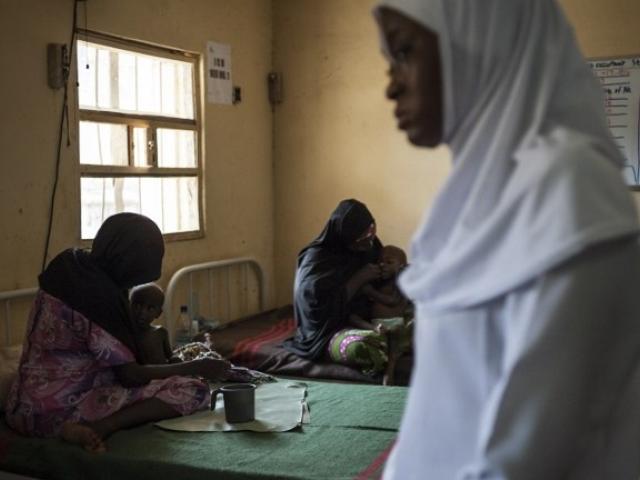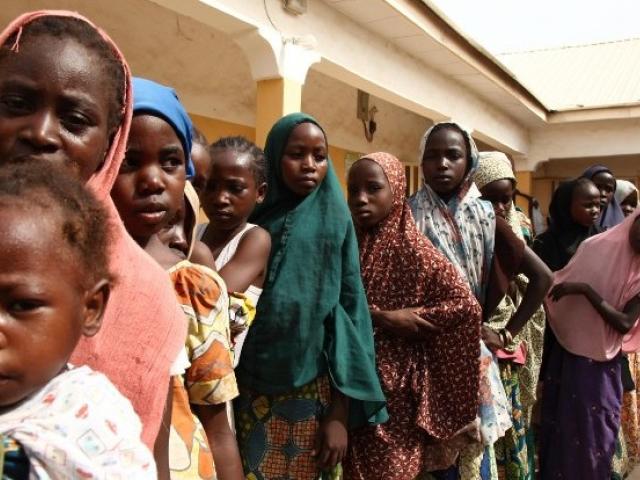One of the United Nations’ sustainable development goals is that people of all ages live healthy lives. A reduction in the adolescent birth rate is seen as one measure of progress on this.
But teenage pregnancy remains a problem in Nigeria, Africa’s most populous country and one of the countries which endorsed the UN goals.
As the clock ticks towards meeting this goal by 2030, this fact-sheet answers key questions around teenage pregnancy in Nigeria.
What is a teenage pregnancy?
The World Health Organization (WHO) defines adolescent or teenage pregnancies as those in young women between the ages of 10 and 19.
The definition for the age of the mother is her age at the time the baby is born. Young women aged 15 to 19 are classified as adolescents, while girls between 10 and 14 are called younger adolescents.
This, the international health agency says, is because “a considerable difference exists between a 12- or 13-year-old girl, and a young woman of say 19”.
Birth and pregnancy rates are given per 1,000 of a specific population. Data comparing countries often gives rates per 1,000 adolescents aged 15 to 19, with the WHO saying similar data on younger adolescents is only “sometimes available”. (Note: The pregnancy rate counts pregnancies ending in births and also in abortions.)
What does the data show?
For an overview of teen pregnancy prevalence in Nigeria, Leo Sanni, the statistical information officer at the National Bureau of Statistics, referred us to two surveys, the Multiple Indicator Cluster Survey (MICS) and the Nigeria Demographic Health Survey (DHS).
The surveys provide a broad and credible view on teen pregnancy in the country, John Ekabua, professor of adolescent gynaecology and reproductive health at the University of Calabar in southern Nigeria, told Africa Check.
-
Multiple Indicator Cluster Survey (2016/`17)
The most recent edition of the MICS survey is from 2016/17. It was conducted by the statistics bureau and the UN Children’s Fund (Unicef) from September 2016 to January 2017. Some 34,376 women aged 15 to 49 were interviewed across 37,440 households nationally.
The survey found that 19.2% of young women aged 15 to 19 had started having children, with 3.1% having given birth before they were 15. The previous survey, in 2011, found almost identical rates.
Over the two surveys, the rate increased slightly among women in rural areas, from 25% in 2011 to 27% in 2017. But it remained nearly constant, at 6.3%, in urban women.
-
Nigeria Demographic Health Survey (2003 to 2018)
The 2018 demographic health survey has the most recent national data on teenage pregnancy. The DHS is carried out every five years.
A total of 8,448 girls aged 15 to 19 were interviewed across the country from August to December 2018. The women were asked if they had had a live birth or were pregnant with a child.
The survey found that 19% of adolescent women had begun having children. The 2013 and 2008 editions of the survey reported this at 23%, a slight decrease from 25% in 2003. The DHS notes that the rate was 28% in 1990.
The rate was higher in rural areas, at 29% in 2003 and 32% in 2018. However, pregnancy rates dipped among girls in urban areas, from 17% in 2003 to 8% in 2018. Research attributes this to increasing levels of education.
The reduction is a signal that with more interventions the drop “might be faster and advantageous to girls growing into teenagers”, Adeleke Ojo, a professor of nursing science at Osun State University in southwestern Nigeria told Africa Check.
What informs the high teenage pregnancy rates?
Omolola Irinoye is professor of nursing at the college of health sciences at Obafemi Awolowo University in southwestern Nigeria. She told Africa Check several factors influence teenage pregnancy in Nigeria, splitting these into family-related and societal.
“Family-related factors have to do with early marriage and parental income. Because of the economic gains of marrying a rich man, some parents force their young girl into early marriage. Lack of parental care and supervision also falls into this category.”
Irinoye said societal factors included community violence, rape, alcohol and substance abuse and low contraceptive use.
The UN Population Fund says teenage pregnancy is a direct consequence of child marriage, a finding mirrored by research in Nigeria.
‘Contradictory laws’
Human rights lawyer Ajibike Arokoyo-Babalola told Africa Check that according to Nigeria’s Child’s Rights Act, no one under 18 was considered “capable of contracting a valid marriage”, but this was not observed in all parts of the country.
“The notion of child marriage is greatly frowned up and even condemned in the southern and eastern part of the country but receives open acceptance in some parts of Nigeria’s northern region,” she said.
She said that the 2003 act had only been adopted by 24 of the 36 states in the federation. This meant that in 12 states girls as young as 12 could still get married. (Note: The act also says that all children must have nine years of compulsory basic education.)
Arokoyo-Babalola also listed gaps in the country’s constitution and laws which she said tacitly encourage child marriage.
For example, in section 277 of the Child’s Rights Act, anyone below age 18 is considered a child, while a section of the constitution provides that “any woman who is married shall be deemed to be of full age”, even if she is younger than 18.
Do different areas of Nigeria have different rates?
The 2018 survey shows female teenagers in Nigeria’s north-west geopolitical region were almost five times (29%) as likely to have had children as their peers in Nigeria’s south-west region (6%).
In Lagos state, the country’s commercial capital, only 1% of adolescent women had started having children, compared to 41% of teens in Bauchi state in northeastern Nigeria.
Experts say low education and high poverty levels are factors for these regional differences.
Dr Kayode Adebayo is a medical director and consultant gynaecologist and obstetrician in Lagos state. He told Africa Check that teenage pregnancies “are more likely to occur in communities driven by poverty and lack of education and employment opportunities”.
Nine states in northern Nigeria had more than 60% of the population living below the poverty line, according to the 2019 poverty and inequality report. Tigawa, Sokoto and Taraba states had the highest rates, at 87% each. The pregnancy rates were 26.9% in Tigawa, 32.1% in Sokoto, and 24.7% in Taraba.
Dr Baba Madu, head of the accounts division at the statistics bureau, said religion in the north, which was predominantly Muslim, was one of the factors that predisposed young women to early pregnancy, as they tended to marry young.
Research and media reporting shows southern states are also affected.
Adebayo added that low school enrolment rates for girls in northern Nigeria also contributed to teenage pregnancy.
What are the health risks?
Teenage pregnancy directly contributed to maternal and child mortality, Abdulkarim Garba Mairiga told Africa Check. He is a professor of reproductive health at the obstetrics and gynaecology department at the University of Maiduguri in the northern state of Borno.
“For many young women, pregnancy and childbirth are neither planned nor wanted. These adolescents end up going for [unsafe] abortion which is also life-threatening,” he said.
According to the WHO, babies born to teenage mothers face higher risks of low birth weight, premature delivery and neonatal conditions, among others.
The DHS 2018 said teenage pregnancy was a major health concern as it was linked to higher morbidity and mortality for both the mother and the child.
“Childbearing during adolescence is known to have adverse social consequences, particularly regarding educational attainment, as women who become mothers in their teens are more likely to drop out of school.”
How does Nigeria compare to other countries?
Ann-Beth Moller, a technical officer at the WHO’s department of sexual and reproductive health and research, referred Africa Check to a database monitoring progress on the sustainable development goals.
Adolescent birth rates in the database were most recently updated in May 2021. They showed Nigeria recorded a yearly average of 106 adolescent births per 1,000 population.
Countries like Mozambique (180 births per 1,000 population), Chad (179.4), Mali (164), Angola (163), Niger Republic (154) and Tanzania (138.9) were higher than Nigeria.
Algeria with 12 births per 1,000 population had the lowest rate in Africa.
What is the government doing about the problem?
The Nigerian government is working with global health partners on reproductive health programmes to tackle adolescent pregnancies. One example is the gender adolescent school health and elderly care programme.
Some states have also done direct intervention programmes. For example, Lagos state set up the Hello Lagos unit to promote sex education and reproductive health services for teenagers.
In northern Nigeria, where early marriage is more prevalent, some non-governmental organisations, such as Raise Foundation, are focusing on improving maternal and child health, including women empowerment and education for girls.
Experts say more can be done, including focusing on child marriage. Enforcing current laws on education and child marriage is one option, human rights lawyer Ajibike Arokoyo-Babalola told Africa Check.
“I strongly believe that, while sensitisation and awareness programmes are good, we have had many of such with minimal improvement. Therefore, constitutional review is highly recommended, or else, 10 years or more from today, we’ll still be faced with the same issues we have now."





Add new comment